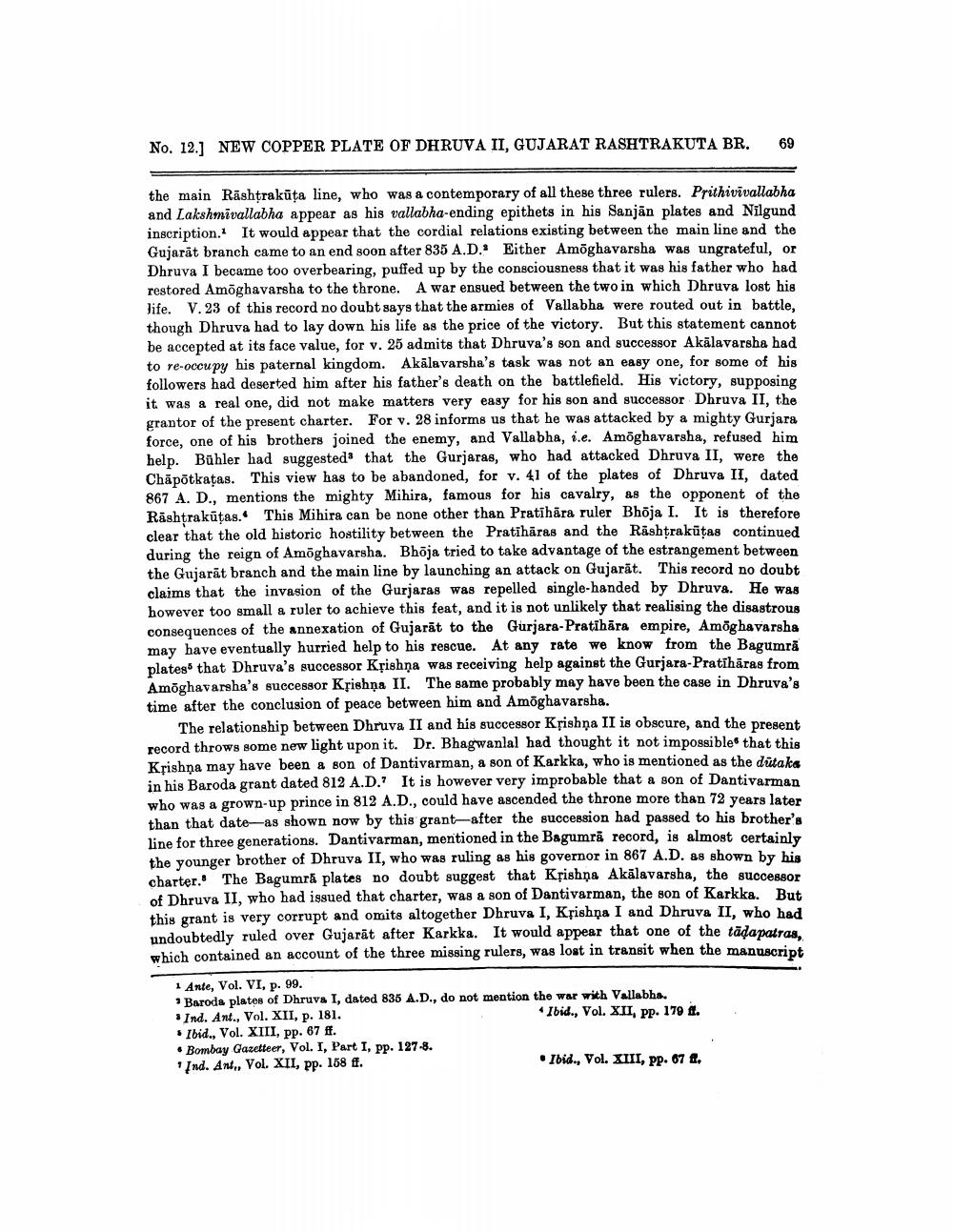________________
No. 12.] NEW COPPER PLATE OF DHRUVA II, GUJARAT RASHTRAKUTA BR.
69
the main Rashtrakūta line, who was a contemporary of all these three rulers. Prithivivallabha and Lakshmivallabha appear as his vallabha-ending epithets in his Sanjān plates and Nilgund inscription. It would appear that the cordial relations existing between the main line and the Gujarat branch came to an end soon after 835 A.D. Either Amõghavarsha was ungrateful, or Dhruva I became too overbearing, puffed up by the consciousness that it was his father who had restored Amöghavarsha to the throne. A war ensued between the two in which Dhruva lost his life. V.23 of this record no doubt says that the armies of Vallabha were routed out in battle, though Dhruva had to lay down his life as the price of the victory. But this statement cannot be accepted at its face value, for v. 25 admits that Dhruva's son and successor Akālavarsha had to re-occupy his paternal kingdom. Akālavarsha's task was not an easy one, for some of his followers had deserted him after his father's death on the battlefield. His victory, supposing it was a real one, did not make matters very easy for his son and successor Dhruva II, the grantor of the present charter. For v. 28 informs us that he was attacked by a mighty Gurjara force, one of his brothers joined the enemy, and Vallabha, i.e. Amõghavarsha, refused him help. Bühler had suggested that the Gurjaras, who had attacked Dhruva II, were the Chāpotkatas. This view has to be abandoned, for v. 41 of the plates of Dhruva II, dated 867 A. D., mentions the mighty Mihira, famous for his cavalry, as the opponent of the Răshtrakūtas. This Mihira can be none other than Pratīhāra ruler Bhöja I. It is therefore clear that the old historic hostility between the Pratihāras and the Rashtrakūtas continued during the reign of Amõghavarsha. Bhöja tried to take advantage of the estrangement between the Gujarat branch and the main line by launching an attack on Gujarāt. This record no doubt claims that the invasion of the Gurjaras was repelled single-handed by Dhruva. He was however too small a ruler to achieve this feat, and it is not unlikely that realising the disastrous consequences of the annexation of Gujarāt to the Gurjara-Pratīhāra empire, Amöghavarsha may have eventually hurried help to his rescue. At any rate we know from the Bagumră plates' that Dhruva's successor Kộishna was receiving help against the Gurjara-Pratīhāras from Amõghavarsha's successor Kpishņa II. The same probably may have been the case in Dhruva's time after the conclusion of peace between him and Amoghavarsha.
The relationship between Dhruva II and his successor Kpishņa II is obscure, and the present record throws some new light upon it. Dr. Bhagwanlal had thought it not impossible that this Krishna may have been a son of Dantivarman, a son of Karkka, who is mentioned as the dutako in his Baroda grant dated 812 A.D.? It is however very improbable that a son of Dantivarman who was a grown-up prince in 812 A.D., could have ascended the throne more than 72 years later than that date-as shown now by this grant-after the succession had passed to his brother's line for three generations. Dantivarman, mentioned in the Bagumră record, is almost certainly the younger brother of Dhruva II, who was ruling as his governor in 867 A.D. as shown by his charter. The Bagumră plates no doubt suggest that Kțishņa Akālavarsha, the successor of Dhruva II, who had issued that charter, was a son of Dantivarman, the son of Karkka. But this grant is very corrupt and omits altogether Dhruva I, Kțishna I and Dhruva II, who had undoubtedly ruled over Gujarāt after Karkka. It would appear that one of the tāda patras, which contained an account of the three missing rulers, was lost in transit when the manuscript
1 Ante, Vol. VI, p. 99. : Baroda plates of Dhruva I, dated 835 A.D., do not mention the war with Vallabhs. Ind. Ant., Vol. XII, p. 181.
Ibid., Vol. XII, pp. 179 f. . Ibid., Vol. XIII, pp. 67 ff. • Bombay Gazetteer, Vol. I, Part I, pp. 127-8. Ind. Ant., Vol. XII, pp. 158 f.
. Ibid., Vol. XIII, pp. 67 f.




